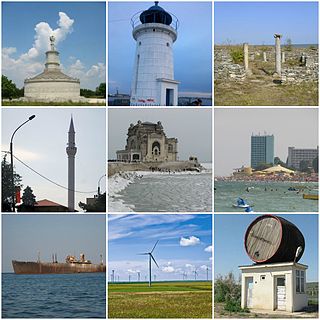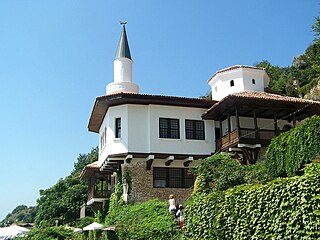
Constanța, historically known as Tomis or Tomi, is a port city in the Dobruja historical region of Romania. As the country's fourth largest city and principal port on the Black Sea coast, Constanța is the capital of Constanța County. It is also the oldest continuously inhabited city in the region, founded around 600 BC, and among the oldest in Europe.

Constanța is a county (județ) of Romania on the border with Bulgaria, in the Dobruja region. Its capital city is also named Constanța.

Tatars of Romania or Dobrujan Tatars are a Turkic ethnic group that have been present in Romania since the 13th century. According to the 2011 census, 20,282 people declared themselves as Tatar, most of them being Crimean Tatars and living in Constanța County. But according to the Democratic Union of Tatar Turkic Muslims of Romania there are 50,000 Tatars in Romania. They are one of the main components of the Muslim community in Romania.

Islam in Romania is followed by only 0.4 percent of the population, but has 700 years of tradition in Northern Dobruja, a region on the Black Sea coast which was part of the Ottoman Empire for almost five centuries. In present-day Romania, most adherents to Islam belong to the Tatar and Turkish ethnic communities and follow the Sunni doctrine. The Islamic religion is one of the 18 rites awarded state recognition.

The Turks of Romania are ethnic Turks who form an ethnic minority in Romania. According to the 2011 census, there were 27,698 Turks living in the country, forming a minority of some 0.15% of the population. Of these, 81.1% were recorded in the Dobruja region of the country's southeast, near the Black Sea, in the counties of Constanța (21,014) and Tulcea (1,891), with a further 8.5% residing in the national capital Bucharest (2,388).

Cobadin is a commune in Constanța County, Northern Dobruja, Romania. The commune includes five villages:

Independența is a commune in Constanța County, Northern Dobruja, Romania. It includes five villages:
Muurat Iusuf is a Romanian Muslim cleric of Tatar origins, currently the Mufti of the Muslim Community in Romania.

Caliacra County was a county (județ) of Romania in the interwar period, in Southern Dobruja, with the seat at Bazargic.

Magdalena-Anca Mircea, better known by her stage name Mădălina Manole, was a Romanian pop recording artist.
Septar Mehmet Yakub (1904–1991) was a Crimean Tatar lawyer, thinker, spiritual leader of Tatars and Turks in Dobruja, Mufti of the Muslim community in Romania. He was a promoter of harmony and peace.
Emin Bektöre was a Dobrujan-born Crimean Tatar folklorist, ethnographer, lyricist, and activist for ethnic Tatar causes.
Emel Emin is a Romanian Crimean Tatar poet, translator, Turkologist, and educator. She writes her work in Turkish. Although most of her poetry is free verse, she sometimes uses syllabic verse and she admires Arabic prosody. With love for traditional forms of poetry she also published ghazal and rubayat. She is associated with the Writers' Union of Romania and Turkish Language Association in Turkey.
Kázím Abdulakim was a Crimean Tatar hero of the Romanian Army who lost his life in the summer of 1917 during the Battle of Mărășești during World War I.
Selim Abdulakim known as the first Crimean Tatar lawyer in Romania was a leading politician of the Tatars in Romania, an activist for ethnic Tatar causes.
Ahmet Nurmambet was a Dobrujan Crimean Tatar who served in the Romanian Army. He was the father of the well-known traditional folk singer Kadriye Nurmambet.

Melek Amet was a Romanian model. As the first Crimean Tatar fashion model in Romania, she broke down barriers and became the symbol of a cultural shift.
Refiyîk Kadír was a Dobrujan-born Crimean Tatar officer regarded as a hero of the Romanian Army. He was the uncle of Ahmet Nurmambet who was the father of the well-known traditional folk singer Kadriye Nurmambet.
Ismail H.A. Ziyaeddin was a Crimean Tatar poet known for adapting the Latin alphabet to the special needs of the Crimean Tatar language and co-authoring the first Tatar language textbooks with Latin script in Romania.
The Dobrujan Tatar alphabet is the writting system of Dobrujan Tatar. Before 1956 only Perso-Arabic script was used and after 1956, Latin alphabet was used.










